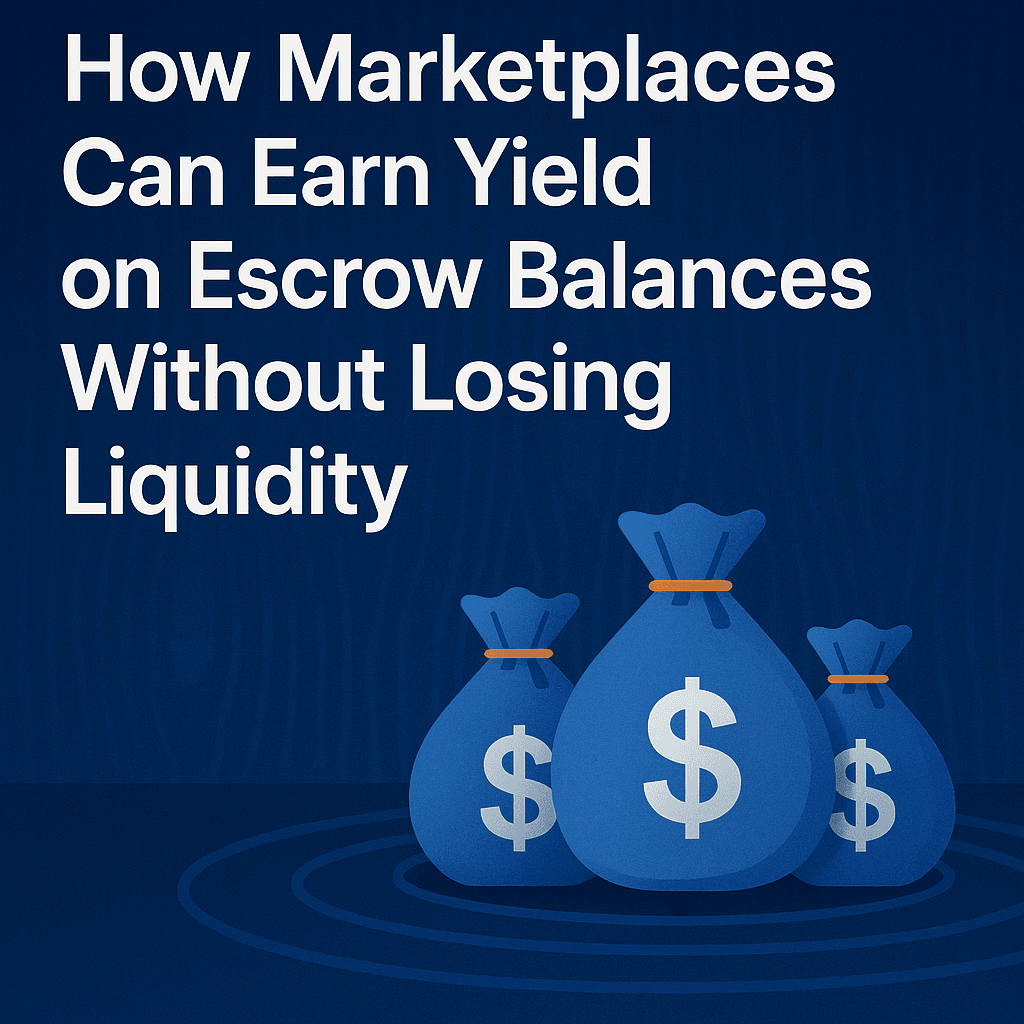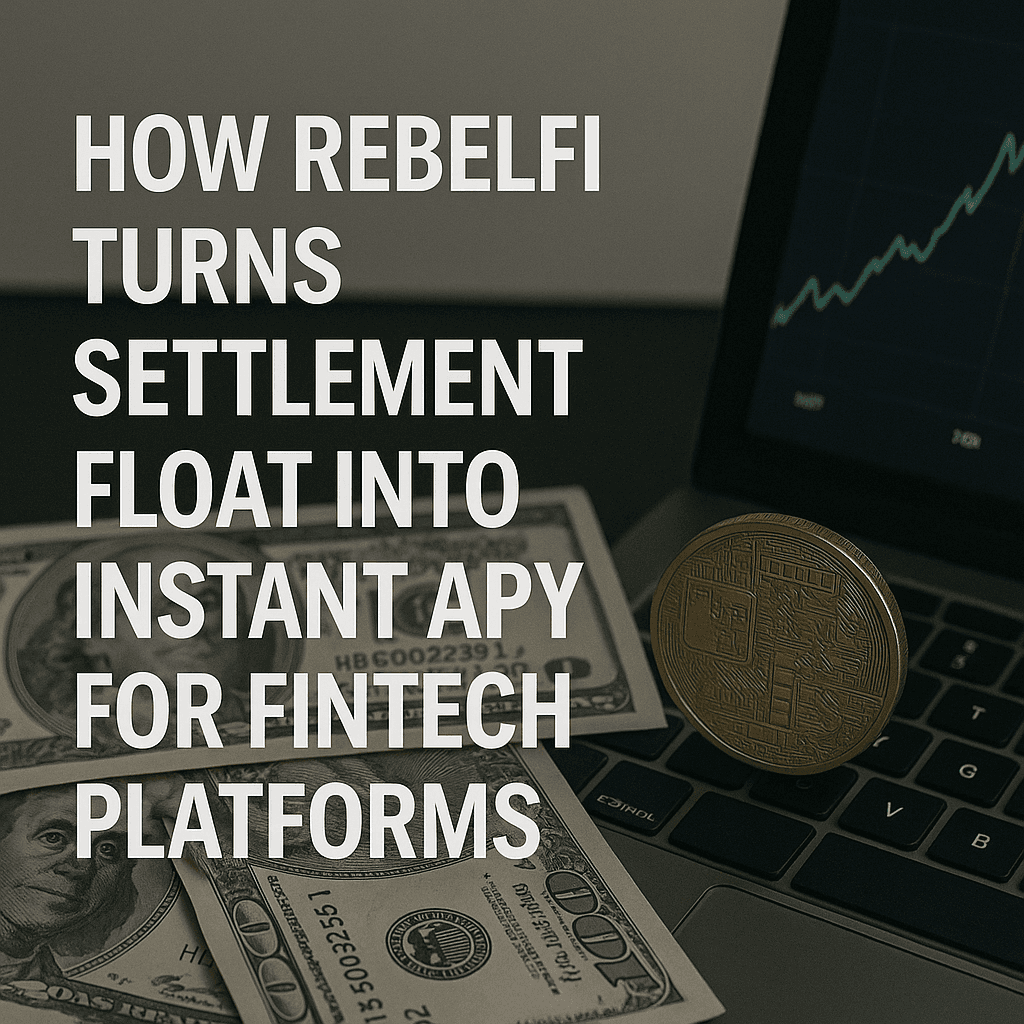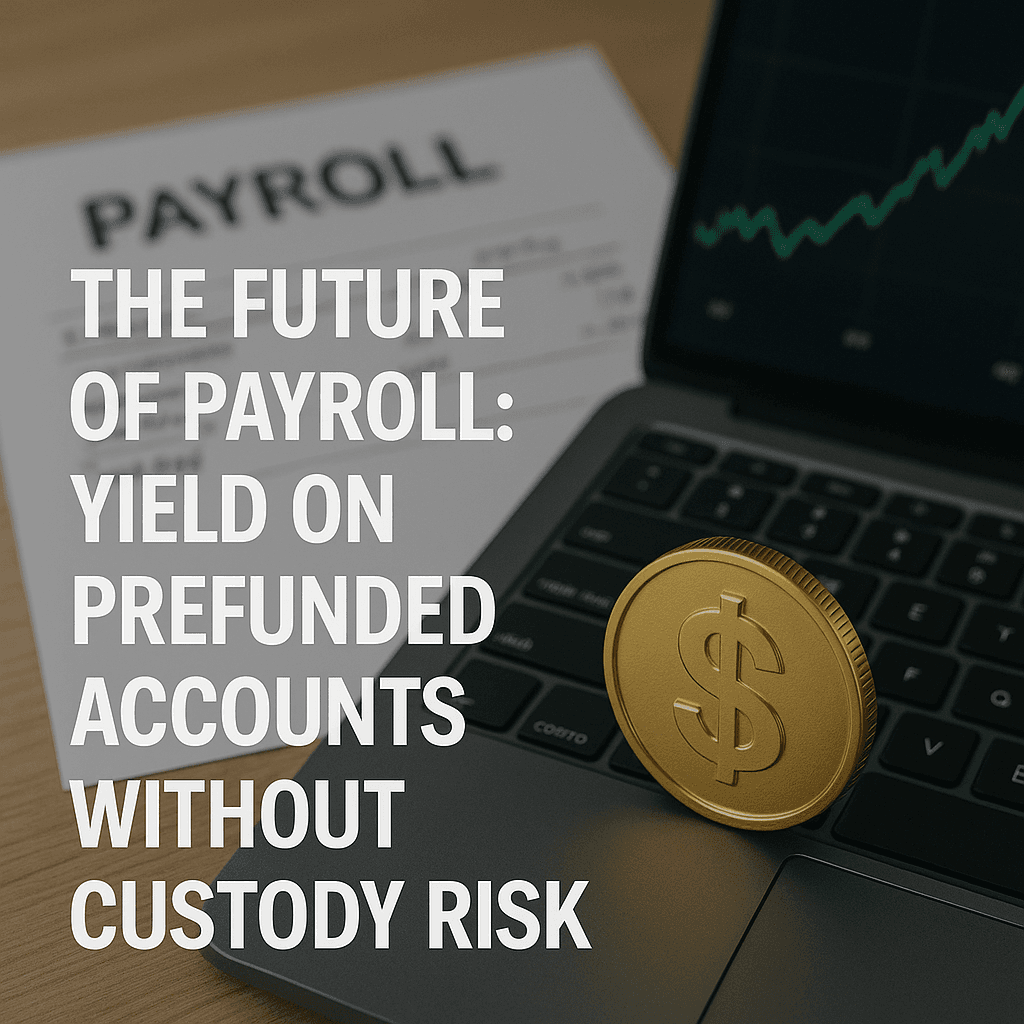The average marketplace holds $1-2 million in escrow at any given time. Under traditional banking, this capital generates practically nothing. But in 2025, forward-thinking platforms are turning this idle float into substantial revenue streams, earning 6-9% APY while actually improving payout speed and seller satisfaction.
The $2 Million Problem Most Marketplaces Ignore
Every time a buyer makes a purchase on your platform, those funds sit in escrow waiting for order completion. For a marketplace processing $50 million annually with a typical 7-day hold period, that means roughly $1 million constantly sitting idle.
Traditional banks pay 0.1-0.5% on these balances. That's $1,000-5,000 per year on a million-dollar float.
Meanwhile, modern yield infrastructure generates $60,000-90,000 annually on the same balance without sacrificing instant liquidity for seller payouts.
Why Traditional Escrow Leaves Money on the Table
The conventional marketplace payment flow follows this pattern:
Buyer pays via credit card or ACH
Funds enter your escrow account at a legacy bank
Money sits idle for 5-14 days during order fulfillment
You process batch payouts to sellers
You collect transaction fees (2-3.5%) to cover costs
This creates multiple problems that compound at scale:
Zero Returns on Float: Bank escrow accounts earn minimal interest while marketplace balances often exceed FDIC insurance limits ($250k per institution).
Seller Cash Flow Problems: 7-14 day payout delays drive your best vendors to competitors offering faster payments.
High Processing Fees: Credit card fees of 2.5-3.5% eat into already thin marketplace margins.
Cross-Border Friction: International sellers face 5-10 day delays and 3-6% currency conversion fees.
A fashion marketplace processing $30 million annually maintains roughly $600,000 average escrow balance. At 0.2% bank interest, this generates $1,200 per year. The same balance earning 7% APY through stablecoin yield protocols produces $42,000 annually, a 3,400% increase.
How Stablecoin Escrow Generates Yield While Maintaining Liquidity
Stablecoins are digital dollars that maintain their $1.00 peg through full reserve backing. USDC, for example, holds $1 in cash and treasury securities for every token issued, with monthly third-party attestations.
When marketplaces route escrow through programmable stablecoin infrastructure, they unlock three simultaneous benefits:
Instant Yield Generation: Funds automatically deploy to audited DeFi lending protocols the moment they enter escrow, earning 6-9% APY.
Maintained Liquidity: Unlike traditional investments with lockup periods, DeFi protocols enable instant withdrawals on demand for seller payouts.
Faster Settlement: Stablecoin payments settle in seconds rather than days, actually improving payout speed compared to traditional banking.
The Technical Process
Modern marketplace escrow using stablecoins works through smart contracts:
Step 1: Buyer Payment → Buyer purchases using stablecoins or credit card (which converts to stablecoins). Funds lock in a smart contract escrow with cryptographic proof.
Step 2: Automatic Yield Deployment → The smart contract immediately deposits stablecoins to yield protocols like Aave (currently 5-12% APY) or tokenized treasury funds like BlackRock's BUIDL (4-5% APY).
Step 3: Order Fulfillment → Seller ships product. Buyer confirms receipt. All trackable on-chain.
Step 4: Instant Payout → Smart contract releases funds to seller. Payout processes in under 60 seconds versus 7-14 days with traditional banking. Seller receives payment plus a share of generated yield.
Step 5: Yield Distribution → Marketplace keeps 40-60% of yield as new revenue. Seller receives remaining yield share. Buyer benefits from stronger escrow protections.
Throughout this entire process, the marketplace maintains complete liquidity. You can process seller payouts instantly on demand because DeFi protocols don't lock funds for fixed terms.
Real Numbers: What Marketplaces Actually Earn
The financial impact scales directly with your escrow balance and hold period:
Small Marketplace Example
Annual Volume: $10 million
Average Escrow Balance: $200,000
Hold Period: 5 days
Yield Rate: 7% APY
Annual Yield Revenue: $14,000
Compared to Bank Interest (0.2%): $400
Incremental Revenue: $13,600
Mid-Size Marketplace Example
Annual Volume: $50 million
Average Escrow Balance: $1 million
Hold Period: 7 days
Yield Rate: 7% APY
Annual Yield Revenue: $70,000
Compared to Bank Interest: $2,000
Incremental Revenue: $68,000
Large Marketplace Example
Annual Volume: $200 million
Average Escrow Balance: $4 million
Hold Period: 10 days
Yield Rate: 8% APY
Annual Yield Revenue: $320,000
Compared to Bank Interest: $8,000
Incremental Revenue: $312,000
An international gig platform processing $75 million annually achieved even better results. By accepting stablecoins and generating yield during their 14-day escrow period, they produced $90,000 in annual yield revenue. More importantly, they reduced cross-border payout costs from $180,000 down to $12,000 by eliminating traditional wire transfers.
Risk Management: Keeping Escrow Safe While Earning Yield
The security model for yield-generating escrow differs fundamentally from traditional banking, but properly implemented systems achieve comparable or superior safety:
Over-Collateralized Lending
When you deposit USDC to Aave, borrowers must post 150% collateral to borrow your funds. If a borrower's collateral drops below 110% of loan value, the protocol automatically liquidates their position and repays lenders. This mechanism has protected billions through multiple market cycles including the 2022 crypto winter.
Protocol Diversification
Smart implementations split escrow across 3-5 audited platforms rather than concentrating in a single protocol. This strategy survived the 2022 DeFi stress period when poorly designed protocols failed while established platforms like Aave and Compound continued operating without loss of user funds.
Tokenized Treasury Funds
For maximum safety, tokenized money market funds offer 4-5% APY backed by U.S. government securities:
BlackRock BUIDL: $2.9 billion in assets, SEC-regulated
Franklin BENJI: $800 million, institutional-grade backing
Ondo OUSG: 5.1% APY, treasury-backed
These provide traditional finance safety with blockchain efficiency.
Real-Time Monitoring
Modern implementations include automated systems monitoring protocol health every blockchain block (every few seconds). If any protocol shows stress signals, the system automatically withdraws funds and redistributes to safer alternatives.
Compared to Traditional Banking
FDIC insurance protects bank deposits up to $250,000 per institution. Marketplace escrow balances typically far exceed this limit, meaning most funds sit uninsured.
By contrast, over-collateralized DeFi protocols have protected billions during major market stress events. The practical risk profile for properly diversified yield strategies compares favorably to traditional banking.
Implementation: Three Paths to Yield-Generating Escrow
Marketplaces have three primary approaches to implementation, each with different tradeoffs:
Option 1: Infrastructure Partner (Fastest)
Partner with specialized providers that handle:
Stablecoin custody and compliance
Automatic yield optimization
Smart contract escrow management
Seller payout processing
Timeline: 4-8 weeks to full deployment Best For: Marketplaces wanting fast implementation without blockchain expertise Example Provider: RebelFi (purpose-built for marketplace escrow)
Option 2: Payment Processor Integration (Mid-Range)
Integrate stablecoin capabilities through your existing payment processor:
Stripe, PayPal adding stablecoin support
Some offer limited yield features
Less marketplace-specific optimization
Timeline: 8-12 weeks Best For: Platforms preferring established payment relationships
Option 3: Custom Development (Full Control)
Build proprietary stablecoin infrastructure:
Maximum control and customization
Requires blockchain development expertise
Ongoing maintenance burden
Timeline: 4-6 months Best For: Large platforms with technical resources and unique requirements
Most mid-market marketplaces choose option 1 to capture yield revenue quickly while minimizing technical complexity.
The Competitive Advantage Window
Early adopters of yield-generating escrow gain compounding advantages:
Seller Acquisition Flywheel: When you offer faster payouts plus yield sharing, you attract high-quality sellers from competing platforms. These sellers bring their customer relationships, improving your marketplace selection and transaction volume. Higher volume increases escrow balances, generating more yield revenue to reinvest in further seller incentives.
Price Flexibility: Platforms generating substantial yield income can reduce transaction fees below competitors' sustainable levels, knowing yield revenue covers the difference. This pricing power accelerates market share gains.
Capital Efficiency: Converting idle escrow into productive capital improves unit economics, enabling you to underprice competitors on both seller fees and buyer costs.
The window for first-mover advantages remains open but is narrowing. Most marketplaces still operate on legacy payment infrastructure. However, major platforms are actively exploring stablecoin integration. Within 18-24 months, yield-generating escrow will likely become standard rather than a differentiator.
Beyond Yield: Additional Operational Benefits
Programmable escrow infrastructure enables improvements beyond direct yield revenue:
Automated Dispute Resolution: Smart contracts handle common scenarios without manual intervention. Delivery confirmation from shipping APIs automatically triggers fund release. Buyer disputes within 48 hours freeze payment for resolution. Multi-signature requirements for high-value transactions provide security without slowing normal operations.
Dynamic Fee Structures: Programmable smart contracts enable early payment discounts that trigger automatically. Volume-based fee reductions activate when sellers reach thresholds. Loyalty programs distribute yield bonuses to top performers without manual calculations.
Instant Cross-Border Expansion: Stablecoin networks operate globally without requiring local banking relationships. Traditional marketplaces spend months establishing payment infrastructure in new countries. Stablecoin-based platforms add new countries in days by simply accepting sellers with wallet addresses.
Reduced Fraud Losses: On-chain transparency and programmable escrow logic reduce fraudulent transactions by 40-60% compared to traditional payment methods.
Regulatory Compliance in 2025
The regulatory landscape for stablecoin marketplace payments has matured significantly:
The GENIUS Act (signed July 2025) established federal regulatory standards for stablecoin issuers, requiring:
1:1 reserve backing with highly liquid assets
Monthly transparency reporting
Priority creditor status for holders in insolvency
Critically for marketplaces: The law prohibits stablecoin issuers from directly offering yield, creating clear separation between issuers (like Circle and USDC) and infrastructure providers (like RebelFi) that generate yield through lending protocols.
This regulatory structure benefits marketplace operators because specialized infrastructure providers can legally deliver yield services while issuers focus on stability and compliance.
Travel Rule Compliance: Cross-border transactions exceeding $3,000 require information transmission. Modern stablecoin infrastructure includes built-in compliance tools that automatically collect and transmit required data.
Money Transmitter Licenses: May apply depending on specific transaction flows and jurisdictions, though many platforms qualify for exemptions when using licensed infrastructure partners.
Getting Started: Calculate Your Opportunity
Determine your potential yield revenue with three simple calculations:
1. Calculate Average Escrow Balance Sum your total escrow balance at month-end for the past 6 months and divide by 6.
2. Determine Average Hold Period Calculate days between payment receipt and seller payout for recent transactions.
3. Estimate Annual Yield Revenue
Formula: (Average Balance) × (Yield Rate) × (Hold Period / 365)
Example: $1.2M × 7% × (7 days / 365) = $1,610 per week = $83,720 annually
Compare this to current bank interest earnings to see your opportunity cost.
Real Implementation: What It Actually Looks Like
A B2B marketplace with $40 million annual volume recently deployed yield-generating escrow through RebelFi:
Month 1-2: Setup and Testing
Integrated RebelFi API with existing checkout flow
Tested stablecoin payment acceptance with pilot sellers
Configured yield optimization parameters
Month 3: Limited Rollout
Offered stablecoin payments to 50 active sellers
38 sellers adopted within 2 weeks (attracted by faster payouts)
Generated $2,400 in yield revenue first month
Month 4-6: Full Platform Launch
Rolled out to all sellers with traditional payments running in parallel
Adoption reached 60% of transaction volume
Monthly yield revenue stabilized at $7,000-8,000
Seller churn decreased 31%
Month 12 Results:
Annual yield revenue: $84,000
Cross-border payment costs reduced: $32,000
Seller acquisition costs down 22% (due to yield sharing pitch)
Total annual impact: $116,000+ in incremental value
The marketplace maintained traditional payment options for sellers preferring legacy systems while capturing yield on the growing stablecoin transaction volume.
Frequently Asked Questions
How liquid are the yield-generating escrow funds?
Completely liquid. Unlike traditional investments with lockup periods, DeFi protocols enable instant withdrawals on demand. Your platform can process seller payouts anytime without waiting periods or penalties.
What if a DeFi protocol fails while holding our escrow?
Proper implementation uses protocol diversification (splitting deposits across 3-5 audited platforms), real-time health monitoring, and automated circuit breakers. Historical data shows diversified strategies across established protocols have maintained capital protection through major market stress events.
Do we need to become a regulated financial institution?
No. By partnering with licensed infrastructure providers, marketplaces can offer yield services without obtaining money transmitter licenses or becoming regulated financial institutions themselves.
How long does implementation take?
With specialized infrastructure providers, most marketplaces deploy initial stablecoin payments in 4-8 weeks. Custom in-house development takes 4-6 months.
Will our sellers understand stablecoins?
Modern implementations abstract blockchain complexity. Sellers simply see faster payouts and potential yield sharing without needing technical knowledge. Many platforms offer both traditional and stablecoin options during transition.
What's the minimum escrow balance where this makes sense?
Platforms with $500,000+ average escrow balances see material revenue impact. Smaller marketplaces still benefit from faster payouts and reduced cross-border costs even if yield revenue remains modest.
How do we handle accounting for yield revenue?
Yield revenue is typically classified as interest income. Most platforms book it separately from transaction fee revenue. Work with your accountant to ensure proper treatment for your specific jurisdiction.
The Bottom Line: Turning Idle Capital Into Revenue
For most marketplaces, escrow float represents the single largest underutilized asset on the balance sheet. A platform with $1 million average escrow balance leaves $60,000-90,000 on the table annually by keeping funds in traditional bank accounts.
Modern stablecoin infrastructure eliminates this opportunity cost while actually improving operational metrics:
Direct yield revenue: 6-9% APY on escrow balances
Faster seller payouts: Seconds instead of days
Reduced transaction costs: Especially for cross-border payments
Lower seller churn: Through yield sharing and better experience
Simplified expansion: No local banking requirements for new markets
The platforms implementing yield-generating escrow infrastructure in 2025 will establish lasting competitive advantages. Those waiting risk falling behind as this technology becomes standard across the industry.
Ready to Turn Your Escrow Float Into Revenue?
RebelFi has built purpose-designed infrastructure specifically for marketplace escrow use cases. The platform combines institutional-grade security with optimal yield generation while maintaining full liquidity for instant seller payouts.
Unlike general-purpose payment processors or pure DeFi protocols, RebelFi addresses the unique requirements of marketplace operators who need to balance yield generation with instant liquidity and regulatory compliance.
The infrastructure exists today to transform your largest idle asset into substantial revenue. The question is whether you'll implement before your competitors do.
Calculate your potential yield revenue or schedule a technical demo at rebelfi.io



